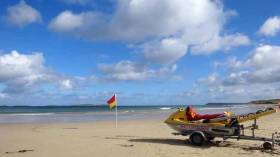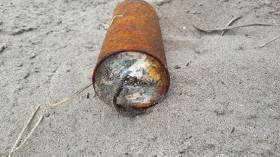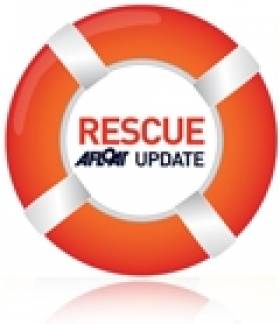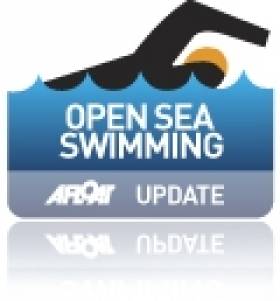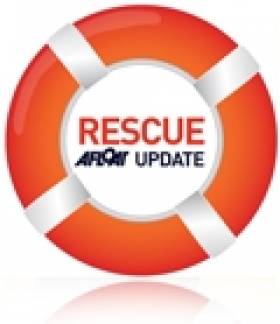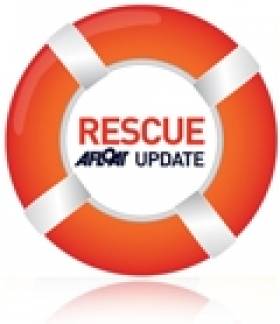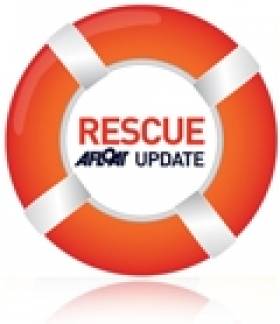Displaying items by tag: lifeguard
RNLI lifeguards return to five Causeway Coast beaches for Easter
RNLI lifeguards will return to five Causeway Coast beaches to provide cover during this year’s Easter holidays.
Commencing this Good Friday (14 April), lifeguards will be operating from Beach Lifeguard Units on Benone Strand, Portstewart Strand, East and West Strands in Portrush and Whiterocks.
The lifeguards will be on duty daily from 11am to 7pm up until Sunday 23 April.
Following the Easter break the lifeguards will resume a weekend duty on the five beaches on the Causeway Coast and also on Tyrella beach in County Down. Daily full time cover will commence on all eight beaches on the Causeway Coast and three in County Down on Saturday 24 June. This will run throughout the summer season finishing on Sunday 3 September. Weekend cover will continue until the end of September.
Ahead of the Easter cover resuming on Good Friday, RNLI lifeguards have spent three weeks in intensive induction training with the lifeguard management team to ensure they are fully prepared for the season ahead.
RNLI lifeguard supervisor Karl O’Neill said they are expecting a busy week: ‘Pre-season preparations have went well and our lifeguards are ready and looking forward to getting back on the beaches and doing what they do best, providing beach safety advice to visitors and helping out anyone who might find themselves in difficulty either in the water or on the beach itself.
We would remind anyone planning a trip to the beach to be mindful that particularly at this stage in the season the water is still cold. Come dressed for the weather conditions to ensure your visit is both safe and enjoyable.’
The RNLI has been working closely with its colleagues in the Causeway Coast and Glens District Council to ensure the beaches and lifeguard units are ready and equipped and that lifeguard training and preparation has been carried out seamlessly and successfully.
‘With the training complete, our lifeguards are looking forward to being back on patrol and putting their skills into action,’ Karl continued. ‘During the Easter break we would encourage visitors to speak to our lifeguards, ask for safety advice, and most importantly call on them should they find themselves in difficulty’.
The RNLI’s advice for anyone planning a trip to the beach is to respect the water, check weather and tide times before you go and if planning to go into the water, swim at a lifeguarded beach, between the red and yellow flags. Avoid using inflatables in strong winds or rough seas.
If you get into trouble, stick your hand in the air and shout for help and if you see someone else in trouble, tell a lifeguard. If you can’t see a lifeguard, call 909 or 112 and ask for the Coastguard.
Last year, lifeguards in Northern Ireland responded to 235 incidents coming to the aid of 255 people. Incidents ranged from saving a life, carrying out a rescue, assisting a casualty, providing casualty care and minor first aid to being involved in searches, near misses and incidents involving missing and found people. The lifeguards also worked closely with their colleagues at Portrush, Newcastle and Kilkeel RNLI lifeboat stations.
RNLI Lifeguards Create Temporary Exclusion Zone on Murlough Beach Following Discovery of Old Mortar Bomb
RNLI lifeguards created an exclusion zone up to 300m on Murlough Beach on Monday afternoon following the discovery of an old mortar bomb.
Senior lifeguard Peter Kinkaid and lifeguard Tommy Murphy were moving the RNLI’s red and yellow flags at approximately 2.30pm when they discovered what they believed to be an old bomb a short distance from the water’s edge between the flags which are used to mark the safest area to swim.
Peter took a photograph of the item and sent it to the local Coastguard unit who shared his view that the object might be an old mortar bomb. The PSNI and the bomb disposal unit were subsequently contacted.
Peter, Tommy and fellow lifeguard Sean McConvey red flagged the relatively quiet area at 3.15pm, before continuing to maintain patrol of the rest of the beach working to keep the small number of visitors away from the area concerned.
On arrival the bomb disposal unit carried out a controlled explosion at 5.20pm before the red and yellow flags were put out again at 5.30pm with normal patrol resuming.
Speaking following the incident, Jason Nugent, RNLI Lifeguard Supervisor said: ‘There have been a number of similar discoveries in recent times with the lifeguards dealing with mortar bomb finds on the beach last summer also. The beach was relatively quiet at the time of this discovery but throughout the operation, the lifeguards maintained patrol of the remainder of the beach and worked to assist and reassure people visiting.
‘While this is nothing to be alarmed about, we would encourage any visitors who may come across any unusual items while on the beach to let us know so we can notify the relevant authorities who can deal with it.’
Lifeguards Rescued 413 Swimmers Last Month
#watersafety – The CEO of Irish Water Safety, John leech is urging the public to use the Local Authority manned lifeguarded bathing places to ensure there are no more swimming tragedies this summer.
Please take heed of advice given by the lifeguards and supervise your children, as lifeguards are not baby sitters.
Lifeguards rescued 413 casualties from our beaches, rivers and lakes during the month of July, that is 146 less than for last July during that memorable heat wave.
There were 353 lost children reunited with their parents.
There were another 8,442 accidents prevented by the proactive actions of our lifeguards.
The CEO is also warning the public that due to the high temperatures in our waters, the prevailing westerly winds and Atlantic current, potentially dangerous jellyfish are appearing on our beaches.
Portuguese man o 'war jelly fish have been reported on Bunmahon and Clonea strand in Waterford, whilst barrel jellyfish have been reported on beaches in Cork.
|
|||||||||||||||||||||||||||||||||||||||||||||||||||||||||||||||||||||||||||||||||||||||||||||||||||||||||||||||||||||||||||||||||||||||||||||||||||||||||||||||||||||||||||||||||||||||
Open Sea Swimming Advice Issued by Irish Water Safety
#watersafety – Irish Water Safety is appealing to the public to stay within their depth when swimming in open water during this current spell of hot weather, following an analysis of the thirteen drownings in last years heat wave.
Swim at Lifeguarded waterways - here
If there is no Lifeguarded waterway nearby then swim at a recognized, traditional bathing area
Swim within your depth - stay within your depth;
Use local knowledge to determine local hazards and safest areas to swim;
Ensure that ringbuoys are present;
Make sure that the edges are shallow shelving so that you can safely and easily enter and exit the water;
Only drink alcohol after your aquatic activity has ended. Stay Away From The Edge after you consume alcohol.
Never bring inflatable toys or floating killers to beaches, lakes or rivers
The majority of drownings, 62%, occur inland where river and lake beds can be difficult to see and therefore extremely difficult to determine if you are swimming within your depth. The onset of cramp, combined with the panicked realisation that you are out of your depth can have tragic consequences and be compounded further by the muscle cooling effect of longer periods in open water. Bear in mind that in a recent analysis on drowning over the last 25 years we discovered that 32% of drowning victims had consumed alcohol so stay away from water when you have been drinking.
If you see someone in difficulty, these simple steps may save a life:
Shout to the casualty and encourage them to shore. This may orientate them just enough.
Reach out with a long object such a branch or a piece of clothing but do not enter the water yourself.
Throw a ringbuoy or any floating object and call 112 for the coast guard.
Clare Lifeguards Set New Records at Lifesaving Championships
#lifeguards – Lifesaving teams from 17 counties competed on Sat 15th Feb 2014 in Irish Water Safety's National Irish Pool Lifesaving Championships. An action-filled day of events saw 240 of Ireland's fittest Lifesavers compete at the University of Limerick's 50-metre pool complex. This year over 100 teams entered from 17 counties around the country - both Ireland and Northern Ireland. Fifteen Irish National Records were broken; 11 new records from Junior age category (13-16) and 4 in Senarios (16+).
"This Annual competition gives the best Lifesavers in Ireland an opportunity to compete in conditions that Lifesavers can encounter in real-life rescue situations. The sport of lifesaving teaches participants the skills necessary to rescue people in distress in water," said Chairman of Irish Water Safety, Breda Collins.
"Many of the competitors, having worked as Lifeguards in pools nationwide, got their chance to pitch their skills against the finest lifesavers in the country," added Collins. "The events are varied and challenging with competitors swimming under immersed obstacles, rescuing "casualties" from the water and skillfully testing a variety of lifesaving skills in the process."
The National Championships are part of Irish Water Safety's (IWS) extensive programme to promote water safety in Ireland with a particular focus on the necessary skills required by pool Lifeguards nationwide. The Championships encourage people to enrol in one of IWS's many courses nationwide in the valuable skills of swimming, rescue and lifesaving. The event promotes the fitness and readiness for action of the lifesavers and demonstrates Lifeguard water rescues to the public.
RESULTS:
Junior Boys: 1st Clare A; 2nd Wexford A; 3rd Sligo.
Junior Girls: 1st Clare A; 2nd Wexford A; 3rd Wicklow.
Senior Men: 1st Clare A; 2nd Waterford A; 3rd Sligo A.
Senior Ladies: 1st Clare A; 2nd Donegal A; 3rd Waterford.
Masters Men: 1st Sligo; 2nd Clare; 3rd Cork.
Masters Ladies: 1st Clare; 2nd Cork;3rd Wicklow.
NEW IRISH RECORDS (description of events below):
100m Manikin Tow with Fins (Boys) Rory McEvoy Clare 1.02.14
100m Manikin Tow with Fins (Girls) Lily Barrett Clare 1.10.47
200m Super Lifesaver (Girls) Lily Barrett Clare 2.44.80
100m Manikin Carry with Fins (Boys) Joseph Mooney Sligo 51.82
100m Manikin Carry with fins (Girls) Georgina Steele Wexford A 1.04.40
50m Manikin Carry (Womens) Lauren Hughes Union (Belfast) 43.18
50m Manikin Carry (Boys) Joseph Mooney Sligo 32.16
50m Manikin Carry (Girls) Georgina Steele Wexford A 40.47
4x25m Manikin Relay (Boys) Clare A 1.24.88
4x25m Manikin Relay (Girls) Clare A 1.31.73
4x25m Manikin Relay (Mens) Clare A 1.24.31
4x50m Medley Relay (Boys) Clare A 1.50.59
4x50m Medley Relay (Girls) Clare A 1.59.34
4x50m Medley Relay (Mens) Clare A 1.46.08
Line Throw (Womens) Wexford 13.13
Galway Lifeguard Praised for Canoe Rescue
#RESCUE - A lifeguard at Galway's Leisureland has been praised for his part in the rescue of a canoeist who got into difficulty in the water off Salthill, as The Connacht Sentinel reports.
Ian Brennan raced to the water after a woman looking across from the Galway Bay Hotel spotted the man in trouble a few hundred yards from the shore and raised the alarm.
The Leisureland duty manager, a former competitive swimmer with experience in water safety, said he didn't think twice about the incident.
"I grabbed a ring buoy, ran across the road, stripped down to my boxers and swam to the person," he said.
Brennan managed to swim ashore with the canoeist as Galway's RNLI lifeboat was being dispatched to the scene.
He also commended the lifeboat crew "for the speed at which they launched" and for their quick treatment of the canoeist for hypothermia.
Despite the applause he received from onlookers once back on land, Brennan described his actions as "no big deal".
The Connacht Sentinel has more on the story HERE.
Lifeguarding in Ireland
It might be hard to believe it but there is plenty of work here in Ireland for the professional lifeguard, from working in a leisure centre swimming pool, to the beautiful beaches around the coast and a beach lifeguard is needed to attain a surf coach qualification according to Muirtí Ó Cearnaigh of Atlantic Coast Lifeguards.
There are slight variations in the qualifications and experience needed to work in both these industries. A lot of people think a lifeguard is a person who is there to save lifes in the event of an accident happening but in actual fact they are there to prevent the incident happening in the first instance. With this they learn about every hazard and risk that is in their particular enviroment and the prevention methods needed to provide safety to the public.
They also learn techniques needed in the event of of actually preforming a rescue, which will include the use of communication with public and casualty, working in a team enviroment, rescue equipment, how to work well with other emergency services, life support, first aid and also train hard in terms of personal fitness.
When you are deciding whether to become a pool lifeguard or beach lifeguard, it really depends on your personal swimming abilty, a pool is a closed enviroment so there is minimum swimming required, where as the beach is a open enviroment so a strong fitness level in swimming is required.
There are two organisations in Ireland in which you can turn to to aquire the certification needed to work in either industry. Institute of Qualified Lifeguards Ireland (Lifeguards Ireland) which receive certification form Royal lifesaving soceity which is endoresed by the international lifesaving federation. And Irish Water Safety which have a very strong youth training programme set out in most counties.
When looking for certification look for out the (NPLQ) National Pool Lifeguard Qualification or (NBLQ) National Beach Lifeguard Qualification, you can find full information on both of these on www.atlanticcoastlifeguards.com where you can also find up and coming courses and any pre requisits needed for each.
Also check out www.lifeguardsireland.com & www.iws.ie for information on other lifesaving or lifeguarding courses nationwide.
Reasons why we think you will want to become a lifeguard:
• First and foremost you are providing an amazing public service. You will without a doubt make people feel confident, happier and safer just by being on the poolside and you could potentially save a life.
• Being a lifeguard offers a fantastic foundation to a career in the leisure industry. Many senior managers began their rise to leisure stardom by lifeguarding at their local pools
• The opportunity to get fit. Not only will you have to have a basic level of fitness to become a lifeguard but you will be encouraged to stay fit and get fitter. Many pools will give their lifeguards discounted or even free memberships.
• You get to work with a team of young like minded people, so there's plenty of opportunity to increase your social circle!
• The hours are flexible and perfect for those of you who need to fit studying into your busy days
• If you're a competitive type there is plenty of opportunity to show off your lifeguarding talents in events like the National Pool Lifeguard Championships (team event) and the Lifeguard Triathlon
• If you find you really enjoy lifeguarding you can take it up as a competitive sport and compete regularly for your local club.
• Lastly but still very importantly, you will gain a life skill that will come in handy for the rest of your life.


























